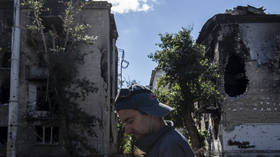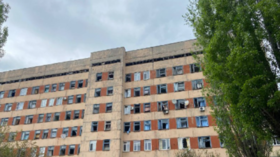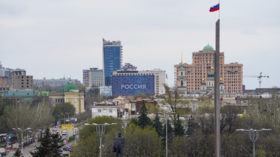Ukraine no longer: How locals are coming together to rebuild Russia’s new Lugansk republic

Amid decimated buildings, residences turned to rubble, abandoned streets, and clear signs of recent bombs and battles, residents of the Lugansk People’s Republic (LPR) are attempting to rebuild and move on, two years into Russia’s military operation.
These are the images I witnessed on my most recent trip to the LPR and its cities which are wrapped up in a battle for survival. Despite significant advances by Russia and the liberation of Avdeevka, the task of rebuilding is not an easy one – especially under the constant threat of Ukraine and NATO attempting another advance.
The LPR has rarely been the center of attention since the start of Russia’s operation, but it was front and center after the 2014 Maidan Coup, when residents fought against the new regime in Kiev. Cities here were among the first areas to break away from Ukrainian control, but suffered great civilian casualties, including journalists simply documenting the evacuation of residents from areas like the small town of Metallist. There’s now a monument dedicated to two reporters who died there in 2014, while doing their jobs in the line of fire.
The head of the Lugansk People’s Republic, Leonid Pasechnik, took questions about the rebuilding process, among other topics. He thanked the Russian president and federal authorities for their help, and stated that other regions were also providing enormous assistance toward restoring and improving infrastructure.
But rebuilding so close to the front line is slow and difficult, with the fear of shelling constantly looming over the heads of the population as they literally pick up the pieces and come together as a community, determined to succeed. In spite of the danger, the world continues turning for the residents who have managed to make progress and rebuild.
One hospital we visited in the city of Krasnodon, on the eastern edge of the republic, was relatively new and equipped with the latest medical technology, which was available for the treatment of local residents free of charge. This was surprising to many for me especially, given the exorbitant cost of healthcare in my native US, where many often would rather suffer injuries and avoid going to the doctor than getting into debt.
According to our guide, injured soldiers from the conflict were rarely admitted to the hospital in Krasnodon, because the area is quiet at the moment. We also visited another hospital that is currently under construction nearby.
The mayor of Krasnodon accompanied us on the tour and gave us some insight into the rebuilding process and the history of the area. Krasnodon is a city with a rich past spanning from World War II, when it was home to the “Young Guard” Soviet underground, which fought Nazis in the occupied territories. A memorial complex and museum in their honor are prominent features of the city.
We got a clear look at how the community is adapting to focus on physical health and children. We had a chance to visit a sports center specifically for children, which had a boxing gym, courts to play basketball, a ballet room for girls, and a 25-meter swimming pool – all available free of charge. The national theater in the area was also under construction, but already functional, contributing to the revival of the community’s cultural life and alleviating the tension of nearby war.
Over on the western side of the LPR, in the city of Severodonetsk, we witnessed one of the most impactful points of any trip to the Donbass region, the results of NATO-made weapons used on civilians and civilian infrastructure. Crumbled buildings, ghostly abandoned streets full of vacant markets, restaurants, and cafes – all signs of another life. One that was bustling here not too long ago.
Every now and then, we could see people walking the streets, and their numbers are set to grow as rebuilding continues in liberated areas. However, the locals we had a chance to speak to said life wasn’t easy, as many still live in apartment buildings that had come under fire. Near one residential complex, we saw a damaged tank that was still stuck following battles that took place here. Even in partially demolished buildings, some residents remain, unwilling to leave their homes, especially now that the war has moved further away and there’s a chance for revival.
We also got to see captured NATO weapons including Javelin missiles, as well as fragments of HIMARS, Storm Shadow missiles, and British anti-tank guided missiles.
There was also a conference held with former Ukrainian soldiers who had switched sides to fight with the Russian Army in the LPR. The most obvious question was why they had switched sides. The answers varied, but all of the men said they were of ethnic Russian origin, spoke Russian, and had family in Russia or nearby Lugansk. Some said they had been treated very badly while fighting for Ukraine because they were ethnic Russians, and had been abused by their comrades.
The oldest man, a Donetsk native, was a chief warrant officer and had been taken prisoner by in Mariupol. He said he had not joined the Russian side in 2014 because his family was located in Ukrainian-controlled areas. But he decided to switch sides after he witnessed targeted killings of civilians in Mariupol by the Ukrainian Armed Forces, and after his experience at the Azovstal plant, the infamous Ukrainian fortress later captured by Russia.
Another man in his 30s said he had joined the Ukrainian Army in 2018 when he had no job or college education, and saw it as his only opportunity. He was sent to Mariupol and ended up in a battalion with Neo-Nazi Azov soldiers until 2019. He witnessed these men paying tribute to Adolf Hitler and Ukraine's own World War Two-era Nazi collaborator Stepan Bandera, playing Nazi music, and giving Nazi salutes. He also said he and a fellow soldier endured many insults for being of Russian origin, and wanted out. They decided to surrender to the Russians when they saw Ukrainians shoot at civilians from Mariupol.
These soldiers also said they hadn’t seen any foreign mercenaries – though one mentioned seeing foreigners aiding Ukrainians in non-fighting roles. When the six soldiers were asked about the 2014 Maidan coup, they said they understood that was when the current conflict began, but that they had not been able to separate facts from propaganda back then. What eventually drove them to fight for Russia, they said, was their own experiences in the Ukrainian Army's ranks, as well as a shared belief that their land and their families had no future without Russia.
What’s notable about Lugansk, and really the entire Donbass region, is the fact that the major cataclysms it has gone through – from the Red Army’s struggle during World War II to the 2014 Maidan revolt, and the 2022 military operation – share the same issues: the fight against forces of a fascistic nature. And now, they are being vilified by much of the West for keeping up this fight.
Throughout their experience, there’s a clear understanding and grasp of history that seems to be missing in the West, especially in the US, and that extends to how communities value and collectively aid each other. We’ve seen the extensive progress in Mariupol, but even in areas like Severodonetsk and within the Lugansk republic, we can see how quickly people in dire circumstances show huge resolve.
One of these people was Yuri Mezinov, who is from Rostov-on-Don and was one of the first to lend a hand in 2014 following the Maidan coup. Yuri has built up a list of contacts in Donbass to aid with humanitarian assistance, including the delivery of food, supplies, and aid to those who need it, including pets and especially children.
He has also gone beyond the essential delivery of aid, helping to restore electricity supplies, rebuilding housing and other structures, as well as putting on shows and activities for young children. For this, Yuri told us, he’s been targeted by Ukraine and put in very dangerous situations. However, he is determined to continue helping. We got the chance to accompany him as he delivered supplies to people, which took a team effort.
When speaking of war, it is essential to remember that the fight is not only taking place on the battlefield, but also in the rebuilding of communities, restoring rubble back to a functioning society. Shortly after we departed Lugansk, a bakery was attacked by Ukrainian forces and several civilians were killed. Attacks like this began way before February 2022, and people in Donbass – whether in Lugansk, Donetsk or elsewhere – continue to face a persistent echo of explosions and uncertainty every day. But for now, at least, the light of victory and the warm blanket of community have begun expanding into many cities, along with a chance to feel a sense of normalcy and calm amidst a now-global crisis.
The statements, views and opinions expressed in this column are solely those of the author and do not necessarily represent those of RT.















